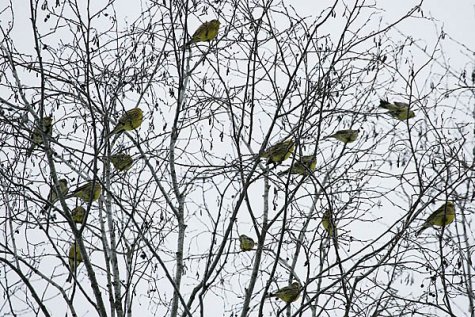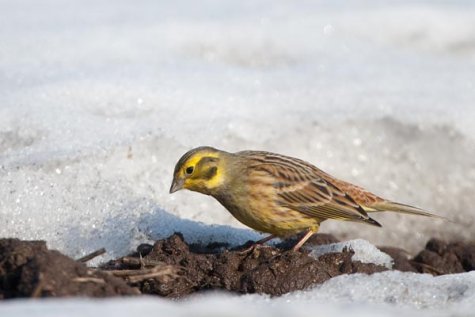Yellowhammers move in flocks
Photo: Arne Ader
Translation: Liis
Yellowhammers on alder branches
Yellowhammer; Yellow bunting Talvike Emberiza citrinella
Yellowhammers are winterers in comparatively low-numbers in Estonia but it varies from year to year; they are noticed because they move in groups and sometimes even in quite large flocks. We meet yellowhammer flocks at road verges, or in groups sitting on power lines, in hayfields looking for the seeds of weeds, in fields, thickets or semi-open landscapes. We see them in the forest camera feeding ground together with tree sparrows and sometimes at birdfeeders where they prefer to feed on the ground. In the old days when horses were still kept yellowhammers were familiar birds in the village landscape picking at horse droppings.
The more days approach spring the more ”golden” the plumage of yellowhammers turns. A passerine with a small beak and relatively long tail: length over 15 centimetres, weight around 30 grams or just a little larger than a tree sparrow.
The plumage colours of yellowhammers vary individually. Back and wing plumage streaked in brown and black, rump rust red and dark streaks noticeable on the breast too. The male’s head is markedly yellow, the female’s more modest; on the crown and behind the eye we notice greyish spots; their plumage is duller but with clearer lengthwise streaks. See also Arne’s photo at the bottom.
Yellowhammers seem a little awkward when moving on the ground; with their species companions they interact peacefully and they trust people – you may approach them until a distance of a couple of metres. Migrants move in great numbers in March, then their quiet, simple and easily recognisable song is heard: tsi-tsi-tsi-tsi-tsi-tsi…. More than 150 000 pairs remain to nest here.
Yellowhammer observations: LINK
Yellowhammer










